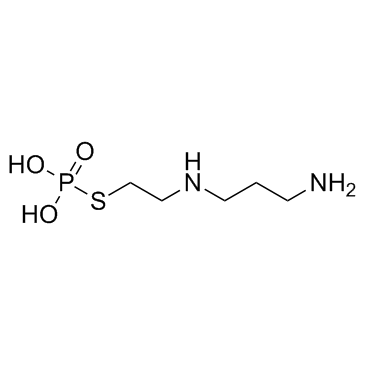
Amifostine
CAS No. 20537-88-6
Amifostine( Amifostine )
Catalog No. M13186 CAS No. 20537-88-6
Amifostine is a cytoprotective adjuvant used in Y chemotherapy and radiotherapy involving DNA-binding chemotherapeutic agents.
Purity : >98% (HPLC)
 COA
COA
 Datasheet
Datasheet
 HNMR
HNMR
 HPLC
HPLC
 MSDS
MSDS
 Handing Instructions
Handing Instructions
| Size | Price / USD | Stock | Quantity |
| 5MG | 28 | In Stock |


|
| 10MG | 41 | In Stock |


|
| 25MG | 97 | In Stock |


|
| 50MG | 180 | In Stock |


|
| 100MG | 300 | In Stock |


|
| 200MG | 447 | In Stock |


|
| 500MG | 716 | In Stock |


|
| 1G | Get Quote | In Stock |


|
Biological Information
-
Product NameAmifostine
-
NoteResearch use only, not for human use.
-
Brief DescriptionAmifostine is a cytoprotective adjuvant used in Y chemotherapy and radiotherapy involving DNA-binding chemotherapeutic agents.
-
DescriptionAmifostine is a cytoprotective adjuvant used in Y chemotherapy and radiotherapy involving DNA-binding chemotherapeutic agents.
-
In Vitro——
-
In VivoAnimal Model:Male C57BL/6 mice with myocardial I/R injury Dosage:400 mg/kg Administration:Intravenous injection; 4 hours Result:Attenuated cardiomyocyte apoptosis and reduced the production of I/R-induced ROS. Significantly reduced the expression of cleaved caspase 3 and Bax whileenhanced the expression of SOD1, SOD2 and Bcl2.Significantly increased SOD activity and reduced MDA levels.
-
SynonymsAmifostine
-
PathwayOthers
-
TargetOther Targets
-
RecptorOthers
-
Research AreaCancer
-
Indication——
Chemical Information
-
CAS Number20537-88-6
-
Formula Weight214.22
-
Molecular FormulaC5H15N2O3PS
-
Purity>98% (HPLC)
-
SolubilitySoluble in Water
-
SMILESNCCCNCCSP(O)(O)=O
-
Chemical Name2-((3-Aminopropyl)amino)-ethanethiol, dihydrogen phosphate ester (9CI)
Shipping & Storage Information
-
Storage(-20℃)
-
ShippingWith Ice Pack
-
Stability≥ 2 years
Reference
1.Kouvaris JR. Oncologist. 12 (6): 738–47
molnova catalog



related products
-
Oxyresveratrol
Oxyresveratro is useful to trauma models, as toxicity to glia could be beneficial by inhibiting reactive gliosis.
-
Phloretin
Phloretin is a well-known inhibitor of eukaryotic urea transporters, blocks VacA-mediated urea and ion transport.
-
Ellagic acid 3-O-α-L...
Ellagic acid 3-O-α-L-rhamnopyranoside is a natural product found in the tuberous roots of [Potentilla anserina].



 Cart
Cart
 sales@molnova.com
sales@molnova.com


